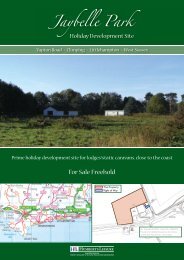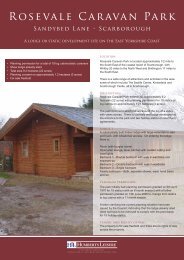0835 Leisure Summer 08_aw.indd - HLL Humberts Leisure
0835 Leisure Summer 08_aw.indd - HLL Humberts Leisure
0835 Leisure Summer 08_aw.indd - HLL Humberts Leisure
- No tags were found...
Create successful ePaper yourself
Turn your PDF publications into a flip-book with our unique Google optimized e-Paper software.
Coastal erosionand Hessle. After the last Ice Age, the ice sheets retreated depositingboulder clay made up of fine silts, boulders and gravel. This is thecomposition of the Holderness Plain today. The soft boulder clay isvery easily eroded, and the cliffs are extremely unstable and liable tocollapse as a result of rain and wave action.Coastal protection measures are in placeat some of the settlements in the area.However, the majority of the coastline remainsvulnerable to this continuing natural process.The average rate of erosion along this coastline is 1.5m a year withrates fluctuating significantly over time and between different areas ofthe coastline. Single events such as storms can result in cliff retreat ofbetween 6-9m at a time.The lost villagesThe problems of coastal erosion along this coastline are nothingnew and one wonders why the policy approach has only come intothe spotlight in more recent years. Since the Roman times a stripapproximately 3.5 miles wide of the present day coastline has beenlost with documented evidence of around 30 villages having oncethrived on this area. Yet still development on the coastline continued.Local planning policyThe current adopted local plans for the coastline area are the EastYorkshire Borough Wide Local Plan (adopted June 1997) and theHolderness District Wide Local Plan (adopted April 1999). Theseare due to be replaced by a single Local Development Plan for thewhole of the East Riding Council area. Policies in the current LocalPlans do make some provision for replacement of caravan sites wherethe existing site is at risk of loss through coastal erosion. The policiesin both Local Plans only allow for new caravan sites within theHolderness Plain coastal area where they will relocate an existing siteat risk of loss through coastal erosion. New sites will not be permittedwithin 400 metres of the cliff top but replacement provision may bemade by way of limited extension on the landward side.This policy is intended to provide the flexibility to replace pitcheslost through coastal erosion, yet the Council’s stated preferenceis that existing sites as risk should be relocated in their entirety toappropriate inland sites. This would appear to be rather impractical.The general aim of the coastal zone policies is to reduce thedominance and visual intrusion of caravan sites, as well as addressingthe practical problems of coastal erosion.Integrated Coastal Zone Management PlanAlthough the Local Authority has a power to provide coast protectionand maintain existing defences under the Coast Protection Act1949, this is not a statutory duty. Previous efforts by the Council toaddress the problem include the Shoreline Management Plan whichwas ultimately never adopted due to concerns over its seeminglynegative approach to “do nothing” in the affected areas. It was alsorecognised that the social and economic issues of coastal erosion, inparticular the value to local communities of the tourism industry wasnot being fully taken into account.The Integrated Coastal Zone Management Plan (ICZMP) wasintroduced in an attempt to bring together all the issues, plans andstrategies for coastal management into a clear set of policy aims. Areport on ‘The rollback of caravan and holiday home parks fromthe eroding East Yorkshire Coastline’ was commissioned as part ofthe work arising from the Management Plan. This was produced inwww.humberts-leisure.comAugust 2003 and has now effectively become the rollback policy ofthe Council.The report identifies 24 sites along the coastline as being at particularrisk from erosion within the next 100 years. The limitations ofadopted Local Plan policies are recognised and more positiveguidance is offered, suggesting that in general there is considerablepotential for the area to absorb tourism development in the formof caravan and holiday park rollback and relocation, the nature ofthe landscape lending itself well to effective screening. However,it recognizes the difficulties encountered in securing appropriatelylocated sites and the economic impact of taking existing sites out ofaction whilst relocation/redevelopment takes place.The report recommends a policy approach which provides for thereplacement of caravan sites at risk of coastal erosion over the next100 years to sites that would not be at risk over that time period(effectively at least 150 metres from the coastline), subject to theremoval of any coast protection works, restoration of vacated land,enhancement of nature conservation resources and provision ofpublic access to the coast.The Council has adopted this as their preferred policy approach butit does not have formal status as supplementary planning guidance.Although cited as a material consideration, it is still the policiesin the adopted Local Plans that are used to consider planningapplications for rollback and relocation of lost pitches, each casebeing considered on its merits.National Planning PolicyThe Good Practice Guide on Planning for Tourism (2006), which ismore up to date than the adopted Local Plans for the area and the 2003report on rollback policy, requires local planning authorities to examinethe scope for relocation <strong>aw</strong>ay from sites prone to coastal erosion butrecognises that the high land values associated with holiday parks, thecost of infrastructure and possible planning issues relating to a proposedsite may make such proposals impractical or unviable.Who should pay?Yorkshire Forward has set up a fund to assist in the realisation ofschemes which meet the objectives of the ICZMP for relocationof caravan sites susceptible to coastal erosion. This fund is to bemanaged by the East Riding of Yorkshire Council. However, inmanaging such funds it will always be necessary to demonstratethat the spending of public monies is for the greater public good,rather than simply propping up private businesses. This willinevitably lead to difficulties as the Council seeks to justify whysome sites are worthy of public subsidy, while other businesses areleft to fend for themselves.Difficulties encountered inseeking a rollback solutionThere are a number of difficulties in seeking a solution throughrollback. Landbanking occurs as developers realise the potential forselling suitable rollback sites as the pressure mounts, whilst somelandowners are unwilling to sell land to adjoining sites as they continueto hold out for the hope value of residential development, despite thisbeing contrary to established local and national planning policy.The preferred approach of relocating entire sites inland, as well asbeing difficult to negotiate, will clearly have significant financialimplications in terms of lost income during the relocation of thepark as well as the potential loss of a more competitive locationimmediately adjacent to the sea where customers prefer to spendtheir holidays.<strong>HLL</strong> <strong>Humberts</strong> <strong>Leisure</strong> 41
















